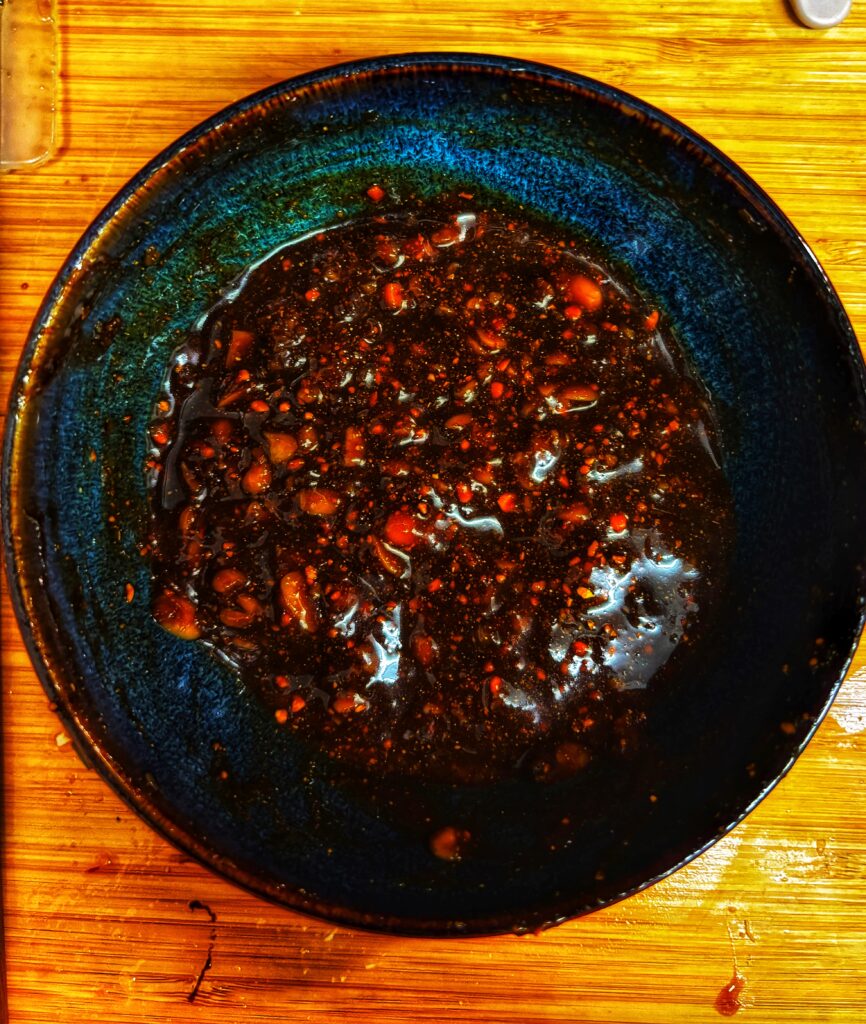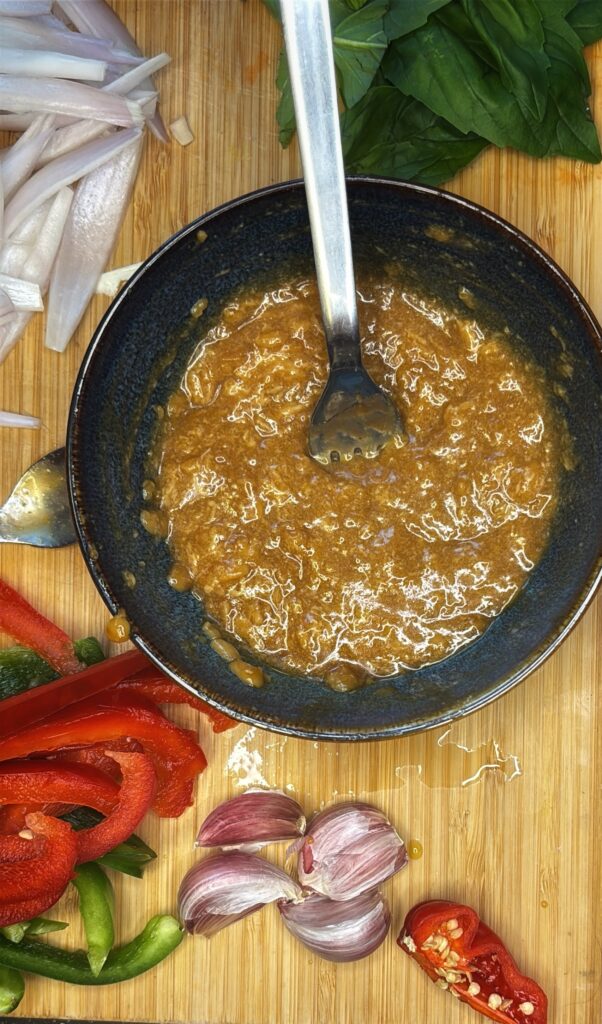This Thai Sauce is perfect for the crowd favourites – Pad Thai, your favourite Thai Basil Fried Rice
Table of Contents
Everyone loves a Thai takeaway. However, I find the vegan and vegetarian options at traditional Thai restaurants quite restrictive. I walk into a hole-in-the-wall Thai restaurant and I am so disappointed when I can’t a vegan Pad Thai.
I know, I know, expecting an authentic Thai restaurant to whip up vegan food for me is too much of an ask. So, I learnt to make a vegan version of this mouthwatering Thai sauce. Furthermore, this Thai sauce recipe for Pad Thai is not just that – it is an extremely versatile dip that you can use as a spread on a toastie, as a sauce on rice paper pancakes, for a Thai-inspired pasta or as the base sauce for a 5-minute noodles lunch.
For starters, try this Thai Basil Fried Rice as a classic pro-tein-packed weeknight dinner that can be enjoyed with the whole family.
This Thai sauce comes together in 10-minutes and can be stored for about a month in the refrigerator. It can also be frozen for up to 3 months.
Ingredients for the Thai Sauce
Makes 350 ml (1 cup)
🔸 8 tbsp Thai miso (Tao Jiew)
🔸 6 tbsp soy sauce (I use Chinese light soy sauce because it is quite similar to Thai soy sauce)
🔸 3 tbsp plain peanut butter
🔸 3 tsp palm sugar (or fine brown sugar)
🔸 2 tsp vegan fish sauce (optional; this is quite salty and you might want to use it sparingly if you are new to this ingredient)
🔸 1 tsp chopped bird’s-eye chillies (optional)
Thai Sauce: Dietary Restrictions and Substitutions
When it comes to Asian cooking, being plant-based, nut-free or gluten-free can be a bit challenging. However, the prethora of gluten-free ingredients in the market is increasing. Add a few clever substitutions and you’ve got recipes that cater to all dietary needs and allergies.
This recipe is naturally vegan if you use vegan fish sauce.
Make it gluten-free: You specifically need to source gluten-free soy sauce as traditional Chinese soy sauce is made using wheat as an ingredient. The same is applicable for vegan fish sauce. Veggie oyster sauce may also contain traces of wheat so for severe allergies (Celiac disease) it is best to buy from a brand that specifically supplies gluten-free sauce. Certain brands like Lee Kum Kee offer gluten-free alternatives for most of these sauces. Finally, do note that Tao Jiew always contains wheat. You can substitute this 1:1 with white miso. Gluten-free miso is available in most supermarkets.
Make it nut-free: If you are allergic to nuts, this might not be the most suitable recipe. This is because most Asian condiments have cross-contamination with peanuts. However, if you can find nut-free vegan fish sauce, oyster sauce, Tao Jiew and soy sauce, you can make this recipe completely nutfree by substituting sunflower butter 1:1 for peanut butter.
Thai Sauce Recipe

1️⃣ Add Tao Jiew to a bowl
Add 8 tbsp Tao Jiew (or white miso) to a bowl. Use the back of the fork to mash the soy beans till you achieve a rough paste-like consistency.
2️⃣ Add the Soy Sauce and Peanut Butter
Add 6 tbsp soy sauce and 3 tbsp peanut butter. Use a spoon to keep beating the peanut butter till the rough Tao Jiew paste, soy sauce and peanut butter combine well to form a slurry.

3️⃣ Complete the Thai sauce and use/store
Now add the chopped chillies, palm sugar and vegan fish sauce. Combine well. Your Thai sauce is now ready to be stored.
Store it in an airtight container in the refrigerator for up to a month. Freeze it in a covered ice cube tray or an airtight container for up to 3 months.
Thai Sauce Recipe for Pad Thai and Fried Rice
Course: Dips, SaucesCuisine: ThaiDifficulty: Easy1
cup15
minutesIngredients
8 tbsp Thai miso (Tao Jiew)
6 tbsp soy sauce (I use Chinese light soy sauce because it is quite similar to Thai soy sauce)
3 tbsp plain peanut butter
3 tsp palm sugar (or fine brown sugar)
1 tsp chopped birds-eye chillies (optional)
2 tsp vegan fish sauce (optional; this is quite salty and you might want to use it sparingly if you are new to this ingredient)
Directions
- Add 8 tbsp Tao Jiew (or white miso) to a bowl. Use the back of the fork to mash the soy beans till you achieve a rough paste-like consistency.
- Add 6 tbsp soy sauce and 3 tbsp peanut butter. Use a spoon to keep beating the peanut butter till the rough Tao Jiew paste, soy sauce and peanut butter combine well to form a slurry.
- Now add the chopped chillies, palm sugar and vegan fish sauce. Combine well. Your Thai sauce is now ready to be stored.
Store it in an airtight container in the refrigerator for up to a month. Freeze it in a covered ice cube tray or an airtight container for up to 3 months.
Notes
- Make it gluten-free: You specifically need to source gluten-free soy sauce as traditional Chinese soy sauce is made using wheat as an ingredient. The same is applicable for vegan fish sauce. Veggie oyster sauce may also contain traces of wheat so for severe allergies (Celiac disease) it is best to buy from a brand that specifically supplies gluten-free sauce. Certain brands like Lee Kum Kee offer gluten-free alternatives for most of these sauces. Tao Jiew always contains wheat. You can substitute this 1:1 with white miso. Gluten-free miso is available in most supermarkets.
- Make it nut-free: If you are allergic to nuts, this might not be the most suitable recipe. This is because most Asian condiments have cross-contamination with peanuts. However, if you can find nut-free vegan fish sauce, oyster sauce, Tao Jiew and soy sauce, you can make this recipe completely nutfree by substituting sunflower butter 1:1 for peanut butter.
If you love Thai food, I promise you that you wouldn’t regret making this sauce in bulk. Let me know which foods you paired this Thai sauce with.



Good https://lc.cx/xjXBQT
Good https://lc.cx/xjXBQT
That’s a great recipe for a vegan Thai sauce! I’ve been looking for versatile sauces to spice up my meals, and this one seems perfect. The fact that it can be stored for a month is a huge plus for meal prep. I’m definitely trying this with rice paper pancakes and noodles. What’s your favorite dish to pair this sauce with?
Love this with rice paper pancakes! My favourite is in fact using this to top seared tofu steaks or spread it as a base sauce on Asian inspired wraps.
Also love it in my Pad Thai. Yes, you are right. It is brilliant for meal prep!
I also love the fact that this sauce can go a long way in fridge cleanup recipes.
I really enjoyed reading about this vegan Thai sauce recipe! It’s great to see such versatile options for plant-based diets. The idea of using it as a spread or sauce for various dishes is so creative. I’m definitely going to try making this for my next meal. Did you come up with this recipe yourself, or was it inspired by a traditional Thai dish?
I look forward to you enjoying this with tofu steaks, wraps and as a dip for rice paper dumplings. Let me know how that goes.
It is inspired by the popular Pad Thai sauce that Thai takeaways reportedly use for most of their dishes! However, this version has lower sodium content and is also vegan 😀
Good https://t.ly/tndaA
Good https://t.ly/tndaA
Very good https://t.ly/tndaA
Very good https://rb.gy/4gq2o4
Very good https://rb.gy/4gq2o4